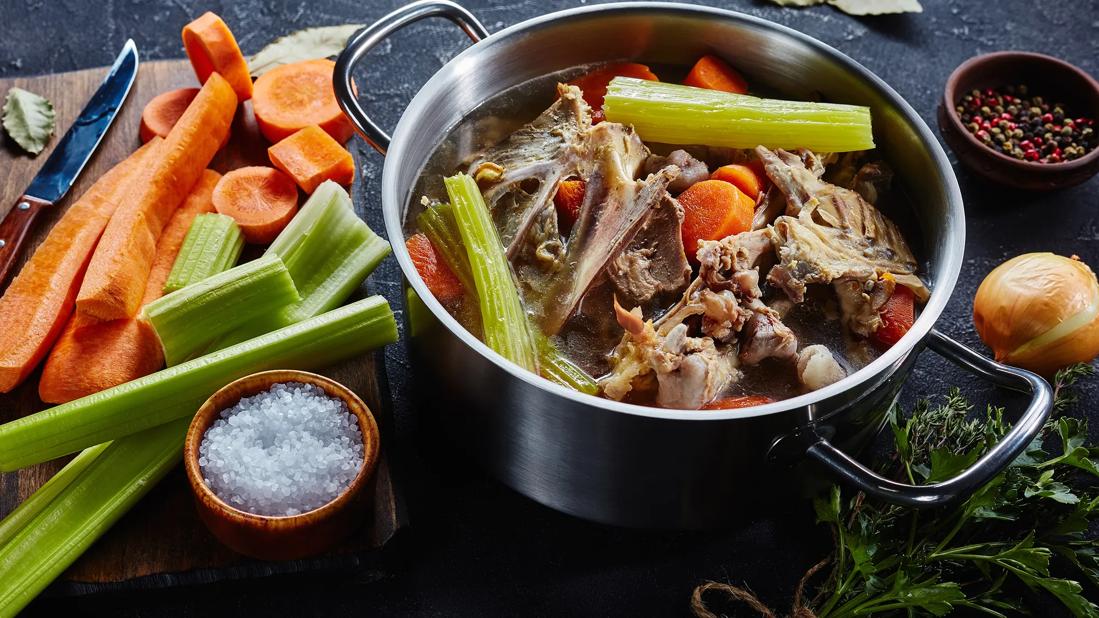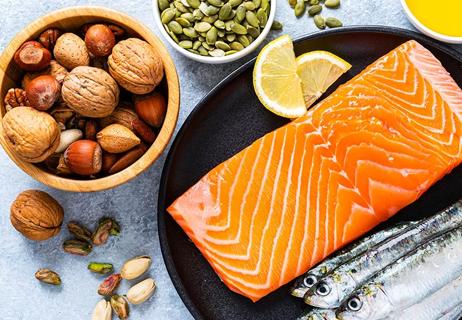Bone broth may help maintain strong bones, improve gut health and even lessen joint pain

Most food trends are a flash in the pan. Anybody remember cronuts? Activated charcoal everything? Bacon-wrapped bacon on bacon, with a side of bacon? Most food fads only survive a few years before being relegated to the walk-in pantry of history. But every once in a while, a food trend becomes a staple.
Advertisement
Cleveland Clinic is a non-profit academic medical center. Advertising on our site helps support our mission. We do not endorse non-Cleveland Clinic products or services. Policy
Popularized in part by the paleo diet, bone broth has been “having a moment” in the United States for several years now. And unlike some of the sexier food fads, its popularity isn’t waning. That’s probably because some are late to the party — bone broth has always been a staple of Asian cooking.
Not only is it tasty, but it’s also versatile. You can use it for soups or rice or just drink it by the mugful. Registered dietitians Kate Patton, MEd, RD, CSSD, LD, and Anthony DiMarino, RD, LD, go over the benefits of bone broth and how to enjoy it.
Bone broth is pretty much what it sounds like: It’s a soup that’s made by boiling animal bones and other ingredients until it soaks up the marrow and other nutrients. Sometimes, meat is boiled in the water as well, along with ingredients like vinegar, tomatoes, garlic or vegetables for added flavor.
The list of health benefits associated with bone broth may be extensive, but there’s still not much research on the stuff. The research that does exist makes clear that not all bone broths are created equal. Homemade or café-made bone broths are the most reliable, but even they vary in nutritional quality from batch to batch.
“Bone broth is a quality addition to a well-rounded, healthy diet,” says DiMarino. “It’s never going to be a silver bullet, but you can add it to your food rotation without having too many concerns. If it’s something you enjoy and you want to make it at home — like if it’s a hobby — and you have the time and the resources, go for it. But if it doesn’t fit your schedule or your budget, don’t worry about it.”
Advertisement
Here are some benefits of bone broth:
Bone broth contains a number of minerals and nutrients that are good for our bodies. For example, collagen is an important protein found in animal bones.
“As we consume that collagen, we break it down,” explains DiMarino. ”Our bodies can then use those amino acids for several reasons. Basically, the body’s going to use it where it needs to use it.”
While further research needs to be done on bone broth’s health benefits, its nutrition profile suggests a wide range of possible ones, including:
Bone broth has potential gut healing and anti-diarrheal properties. The lining of our gastrointestinal (GI) tract thins over time. There’s some evidence that boosting collagen production helps restore that lining. And a non-human study in 2021 found that, due to its anti-inflammatory properties, bone broth may be able to lessen the damage done to the gut from ulcerative colitis.
As many of us are all too aware, as we age, our joints lose elasticity, resulting in problems like osteoarthritis. A boost of collagen — one of the primary proteins in our bodies — can help reduce joint pain by protecting your tendons and ligaments. When bone broth is cooked, the collagen in the animal bones breaks down to create gelatin. This has amino acids that can support joint health as well.
Collagen is one of the primary components of both our bones and muscles. So, as we lose collagen, both our bones and muscles can weaken, which raises our risk of osteoporosis and sarcopenia.
Collagen-rich bone broth is also a good source of amino acids, which are easily absorbed in broth and can help build tissues, muscles and bones.
Electrolytes like calcium, potassium, sodium and magnesium are also present in bone broth, which help regulate nerve and muscle function and even prevent cramping.
Collagen contains an amino acid called glycine, which helps inhibit stress, enhance mental clarity and promote sleep. Also — let’s be real — warm beverages are soothing, regardless of their glycine content.
Collagen has long been touted as a natural way to strengthen skin elasticity, thereby reducing signs of aging like wrinkles and crepey skin. But there may not be enough research currently to support this.
The biggest factor bone broth has going for it is the ample nutrients and minerals you can get from it. But it’s important to note that the nutritional content of your bone broth will depend on the type of animal bones you use.
In general, one cup of bone broth includes:
Advertisement
A standard stock uses meat, bones, water, seasoning and, sometimes, a mirepoix. A mirepoix is a mix of aromatics like chopped onions, carrots and celery that gives your stock an added depth of flavor. Most stocks use beef, chicken or fish as a base, but don’t despair, vegetarians! It’s just as easy to buy or make vegetable stock.
If you’re in the mood to DIY, making stock is about as easy as it gets. You just add your ingredients into a pot and let them simmer. All told, it takes between two to three hours on a stovetop to make a decent stock — even less if you’re using a pressure cooker.
Bone broth uses similar ingredients and requires minimal prep, but it’s much more time-intensive. Bone broth should simmer for a minimum of six hours and higher quality bone broth spends 24-plus hours on the stove. All that extra time helps pull nutrients out of the bones, rendering the broth thicker, healthier and more gelatinous than a stock. You can also dress up your bone broth with some herbs and spices, if you like.
According to DiMarino, the collagen content in bone broth is what makes it worth the extra prep time.
If you’re buying bone broth from a grocery store, keep in mind that companies can label their broth “bone broth” as long as they used bones to make it — even if the broth and bones only cooked together for a few minutes. A quality bone broth should be cooked with bones for at least six hours.
Advertisement
So, how do you know if you’re buying high-quality bone broth? When refrigerated, it should take on a gel-like texture. That’s how you know there’s collagen, amino acids and other nutrients in the mix.
Also, look in the freezer section — bone broth remains intact during the freezing process and can stay good for anywhere from 12 to 24 months, depending on the brand and preparation.
If none of those options appeal to you, you can also purchase powder or supplement forms such as collagen peptides or bone broth powders, which offer the same nutrients.
Due to the potassium, sodium, protein and liquid content of bone broth, check with your healthcare provider before consuming if you have kidney disease.
If you want to give it a go yourself, we recommend slow cooker bone broth using beef, venison or poultry bones. You can also try Thai coconut bone broth with hot chilies, lemongrass and ginger.
Ingredients
Advertisement
Directions
Eventually, the hype around bone broth may die down, either because it fully integrates into food culture or because — like quinoa and açaí before it — it becomes the province of health-conscious foodies with a taste for international cuisine. Either way, its health benefits stand.
Learn more about our editorial process.
Advertisement

Leucine is an amino acid that helps you build muscle — it’s found in both plant and animal protein

Adding protein powder to coffee can provide benefits, but ‘proffee’ is no substitute for nutritious food

While rare in the U.S., signs that you’re not getting enough of this essential macronutrient include muscle loss, skin changes and a weak immune system

The concept of morning protein and exercise isn’t backed by research but may have some potential benefits

The general rule is 0.8 to 1 gram of protein per kilogram of body weight — but that may not be right for you

This edible insect powder can be a good source of protein, fiber and other nutrients

This amino acid is in lots of energy drinks, but our bodies already make all we need

Some options like chicken breast and beans are better for you than processed meats or dairy

If you’re feeling short of breath, sleep can be tough — propping yourself up or sleeping on your side may help

If you fear the unknown or find yourself needing reassurance often, you may identify with this attachment style

If you’re looking to boost your gut health, it’s better to get fiber from whole foods